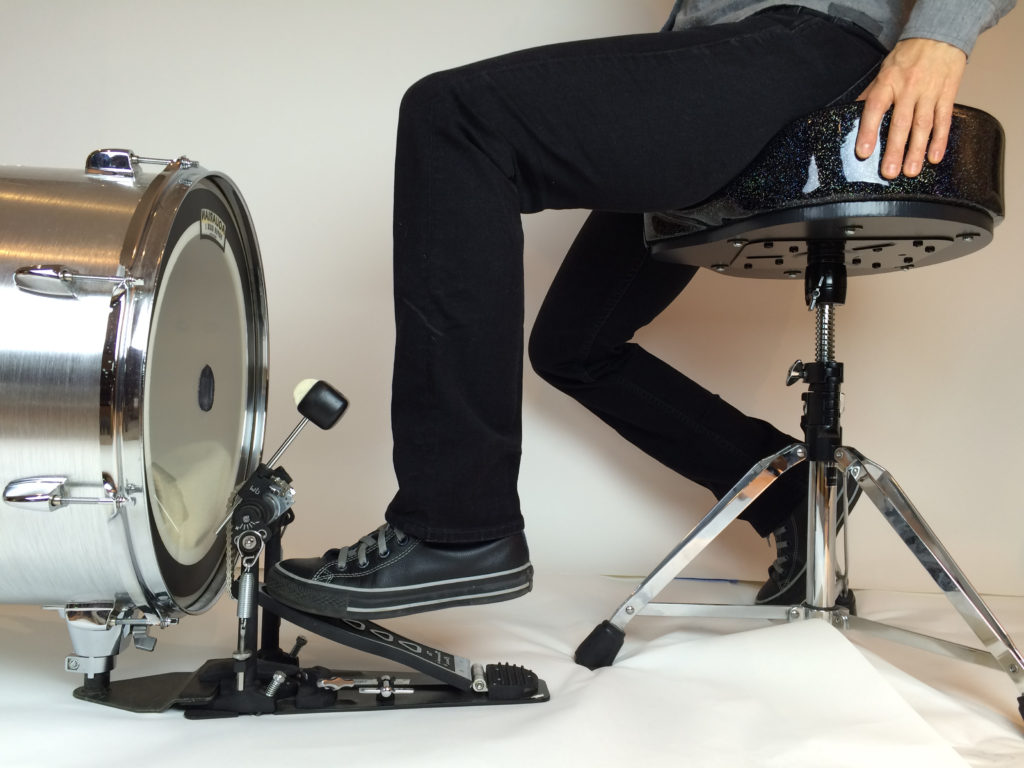By JJ Jones
Greater stamina, control, precision and speed on the kick drum can provide us with so many more options as drummers: complex grooves, fast tempos, more interesting fills, and a wider variety of musical styles, not to mention improving our time-feel and ability to lock in with a bass player. In this Part I installment, “Pedal Techniques”, we examine the multitude of methods that can be used on the kick drum pedal. As you might guess, each one is appropriate for specific styles, applications, and situations.
Heel-Up

By far the most common technique used on the kick drum pedal, this method typically provides the most power, speed, and volume. It involves using the entire leg to move the pedal up and down, meaning the force behind the beater is being provided by some of the largest muscles in your body. To play heel-up, place the ball of your foot about a quarter of the way down the pedal footboard and keep it there while lifting your leg from the hip. Use the leg muscles and the weight of your leg to push the pedal down (see Fig 1). The heel-up method is highly versatile and can be used in almost every musical style. If you’re looking for LOUD, this is the technique to use!
Heel-Down

Heel-down is often how beginners first play the bass drum, since their muscles are usually not yet developed enough to move their whole leg up and down (like in heel-up) and still have control. Heel-down involves resting the heel on the bottom of the footboard and moving the pedal up and down by bending at the ankle (see Fig 2). This method is employed mainly for jazz and lower volume settings, since using only your foot and calf muscles usually means less power is translated to the beater. A great application for heel-down is “feathering” in jazz and swing styles, where the drummer keeps very light quarter-notes going on the bass drum throughout (see Fig 3).

Burying The Beater

A somewhat controversial issue in drumming, whether to “bury the beater” is a topic of debate. This technique involves letting the beater rest on the head of the bass drum on every strike (see Fig 4). The result is less resonance and more emphasis on the attack, and the leg is allowed to rest briefly between each hit. On the converse, letting the beater bounce back after every stroke (by pulling the foot back or bending the ankle), allows the kick drum to fully resonate in the same way toms do after being hit by a stick, and both attack and sustain are heard. Many studio engineers prefer this method as it can give a better bass drum sound on recordings. Knowing how to do both techniques, based on what the musical situation calls for, is ideal.
Skip (Slide) and Heel-Toe

Used for very fast doubles and triples on the bass drum, the slide involves “skipping” the foot across the pedal to get two or even three hits of the beater with one downward movement of the leg (see Fig 5). The heel-toe method is similar, but the multiple hits come from the heel coming down on the pedal first, then the toe, producing, again, two strikes of the beater out of one downward movement of the leg (see Fig 6).

Gear used in the gifs: 16″ Yamaha Manu Katché Signature kick drum, DW 5000 kick drum pedal.
Stay tuned for Part II in the Focus On The Bass Drum series, “Control and Stamina”, which will include kick drum warm-ups, drills, exercises, and song/groove transcriptions for the development of control and stamina in your bass drum leg and foot. Part III, “Speed”, will be devoted almost entirely to the skip and heel-toe methods, so keep an eye out for that if you’re interested in playing faster.
JJ Jones is an internationally touring, Berklee-trained drummer and educator. She has played with folk-pop darlings Girlyman, singer/songwriter Lucy Wainwright Roche, comedian Margaret Cho, LA’s riot-pop band WASI, and Egyptian revolutionary Ramy Essam, among many others. She is the founder of EmpowerDrumming.com.


